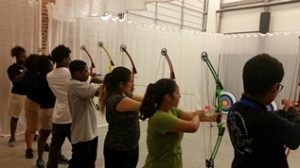 Forty Detroit youth and young adults kicked off the second annual Department of Natural Resources Detroit Youth Conservation Academy July 12 at the DNR Outdoor Adventure Center (OAC) in downtown Detroit.
Forty Detroit youth and young adults kicked off the second annual Department of Natural Resources Detroit Youth Conservation Academy July 12 at the DNR Outdoor Adventure Center (OAC) in downtown Detroit.Held every Tuesday for six weeks at the OAC or Belle Isle Park, the academy offers hands-on, natural resource-based learning from DNR representatives in law enforcement, marketing and outreach, forestry, historical resources, fisheries, wildlife, parks and recreation, land management and more. In addition, academy participants are learning about the many careers available within the DNR and the next steps to seeking positions within the department.
Through a home-study hunter education program offered through the academy (and offered to all Michigan citizens), participants will have the opportunity to earn Michigan hunter safety certificates, allowing them to purchase hunting licenses.
Students were selected from five Detroit-based Summer Youth Employment Initiative groups, including Detroit Employment Solutions Corporation, Detroit Zoological Society, Healthy Kidz, Inc., The Youth Connection, Inc. and Urban Neighborhood Initiatives. The youth and young adults have established mentors and supervisors from these groups who will support their efforts and development through the academy.
“The Youth Conservation Academy offers a great opportunity for Detroit-area youth and young adults to learn about natural resources conservation and management and the many career fields within the DNR,” said Gary Hagler, DNR Law Enforcement Division chief and academy organizer. “These are the next generation of conservation stewards, and the DNR is honored to play an important role in their conservation training.”

The students will graduate from the academy Aug. 16, equipped with the knowledge and information needed to become fully engaged in conservation, stewards of Michigan’s natural resources and educated on the many career possibilities available within the DNR.
Each week, follow these youth and young adults, ages 16-19, in this blog as they work their way through the academy.
The blog will be posted weekly on the Michigan DNR’s Facebook page and at www.michigan.gov/dnreducation by clicking on “Conservation Youth Academy 2016” found under the “Youth Programs” heading.
Session One – Law Enforcement/Marketing and Outreach
At 10 a.m. July 12, DNR Law Enforcement Division Chief Gary Hagler welcomed the 40 academy participants to the second annual DNR Detroit Youth Conservation Academy, held at the DNR Outdoor Adventure Center in downtown Detroit.
Michigan’s natural resources
After the students completed a survey on their recreational outdoor activities and interests, Janet Canode, community outreach education specialist from the DNR Marketing and Outreach Division, discussed the need for natural resources conservation and management in Michigan.
The roles played in natural resources conservation and management by the DNR, its partners and the citizens of the state are crucial. With 11,000 inland lakes, 103 state parks and over 4 million acres of public land, just to name a few assets, Michigan’s natural resources are second to none.
The Michigan Department of Conservation – which later became the DNR – was established in 1921 to manage these resources, from deer to fish to timber and so much more. With too many resources being taken too quickly, natural resources conservation and wise management practices were essential then and continue to be extremely important today.
DNR careers
Canode then gave an overview of the many careers available within the DNR to help conserve and manage our state’s resources. From conservation officers to accountants to website administrators and wildlife and fisheries biologists, the career possibilities are endless.
Conservation officer careers
Before lunch, Sgt. Damon Owens, law supervisor from district nine (which includes Wayne County, among six others), discussed job duties and responsibilities of a Michigan DNR conservation officer.
“Conservation officers are fully commissioned state peace officers who not only provide natural resources protection and ensure recreational safety, but also provide general law enforcement duties in the communities they serve,” Owens explained. “Many times, they are the first to respond to an emergency situation, providing lifesaving operations such as search-and-rescue, ice rescue, first aid and CPR.”
Owens covered conservation officer education requirements, the application process, the 22-week conservation officer academy and field training assignments. He also discussed the everyday tools and equipment used by conservation officers and went over “a day in the life” of a conservation officer, noting that no two days are ever the same.
Hunter safety program
After lunch, Cpl. Peggy Ruby – a conservation officer – passed out and discussed hunter safety education home-study packets. The students will study their hunter safety booklets at home, complete necessary written assignments, and during the fifth academy session Aug. 9, take the multiple-choice hunter education test.
Participants also will complete their hunter safety field-day training during session five, using simulated shooting methods. If they score a certain percentage correct on the written hunter education test, as holds true with all Michigan citizens who take the test, they will earn a Michigan hunter safety certificate, allowing them to purchase hunting licenses.
Archery indoors
For the final 90 minutes of the session, participants were split into two groups, which rotated assigned areas. One group learned archery at the indoor OAC archery range, taught by Kathy Garland, National Archery in the Schools coordinator.
The other group played natural resource-based conservation games on the facility lawn, led by Canode.
“Oh, Deer”
During the first game, “Oh, Deer,” students were assigned to be a deer, shelter, food or water, giving hand signals for the latter three. The “deer” were each assigned to find one of the three: shelter, food or water. If the “deer” couldn’t find what they were assigned, they exited the game.
“This taught students about balance in nature,” Canode said. “By the end of the game, participants saw a large number of deer but no habitat, food or water. If it were to be played again, they may see a large amount of habitat remaining but few or no deer.”
How many bears?
The second game (called “How many bears can live in this woods?”) focused on bear habitat. The game began with students standing in a circle. Pieces of paper, which were designated as pounds of fruit or meat, were thrown into the center of the circle. The “bears” had to grab as many pounds of fruit and meat as possible. They needed 80 pounds of food to stay in the game. This is the amount of food consumed by a typical bear during a 10-day period.
“To make the game more interesting and realistic, one ‘bear’ was blindfolded but still had to collect 80 pounds of food, and another ‘bear’ was assigned a broken leg and so could only hop when retrieving food,” Canode said. “A third bear was noted to be a mother with two cubs, and so had to collect twice as much food as the other bears.”
The game taught participants about the balance between bear population and available food. The youth and young adults completed the day back in the classroom to discuss the first session. They will return to the OAC July 19 for session two, which will focus on historical resources and minerals management.
For more information on the DNR Detroit Youth Conservation Academy, call 517-284-6000 or visitwww.michigan.gov/dnreducation and click on “Conservation Youth Academy 2016” found under the “Youth Programs” heading.



